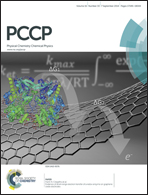Hexagonal ice stability and growth in the presence of glyoxal and secondary organic aerosols†
Abstract
The presence of ice dominates the microphysics of formation of high altitude cirrus and polar stratospheric clouds, as well as the maturity of thunderstorms. We report on the hexagonal (1h) ice stability and growth in binary as well as multi-compound aerosols in atmospherically relevant conformations. The ubiquitous atmospheric trace gas glyoxal along with secondary organic aerosol (SOA) also in the presence of CO2 interacts with large ice 1h crystals of 1300–2000 water molecules. The crystals are subjected to phase transitions under superheating and supercooling conditions by Molecular Dynamics (MD) simulations. Density Functional Theory (DFT) based geometry optimization and vibrational frequency analysis are also employed for a smaller ice 1h cell of 12 water molecules. The interaction of the latter with each organic molecule reveals the extent of the mechanical stress exerted on the ordered ice structure. Full hydration of glyoxal promotes ice 1h stability and growth in wet aerosols, while partial hydration or full oxidation exerts a destabilizing effect on the ice 1h lattice. This behavior is associated with the ability of each organic phase to match the order of the ice 1h crystal. We propose that aqueous chemistry in wet aerosols may also have a strong effect on the microphysics of cloud formation.


 Please wait while we load your content...
Please wait while we load your content...